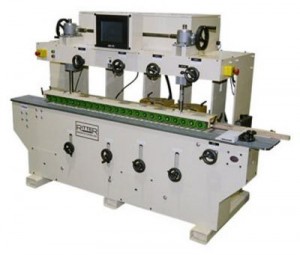 Also known as a spindle moulder, a wood shaper is a stationary machine that uses a high speed, vertical spindle mounted with cutter heads to mould wood pieces into profiles. In terms of profile cutting, shapers and handheld routers perform the same function, with the former being intended for heavier work. However, to execute the more intricate profiles, some woodworkers require a CNC router, a stationary, computer controlled router that can cut highly intricate profiles at a high rate. But for woodshops whose production rate is low to moderate, a wood shaper is usually the best choice.
Also known as a spindle moulder, a wood shaper is a stationary machine that uses a high speed, vertical spindle mounted with cutter heads to mould wood pieces into profiles. In terms of profile cutting, shapers and handheld routers perform the same function, with the former being intended for heavier work. However, to execute the more intricate profiles, some woodworkers require a CNC router, a stationary, computer controlled router that can cut highly intricate profiles at a high rate. But for woodshops whose production rate is low to moderate, a wood shaper is usually the best choice.
Buying the Right Shaper for your Needs
As you shop for a moulder, your first consideration should be production rate. If your production rate is growing, as opposed to being predicted to grow, then buying a moulder whose capacity exceeds your current output is a wise choice. But, if you’re considering a moulder as a substitute for a CNC router, be sure that it offers the necessary profiling capabilities and production rate. CNC routers typically cost more than moulders, but buying them used from a reputable source can bring significant savings.
In addition to choosing the right machine in terms of output, you’ll need to evaluate how it would fit in your workspace. Growing woodshops often upgrade their machines from commercial grade to industrial grade without first updating their workspace to accommodate the latter’s larger size. Having one industrial size machine in your workshop might not impede on its workspace, but additional ones likely would. To choose the right machine in terms of space, remember two things: (1) don’t choose a machine whose size is unrealistic for your space, and (2) don’t choose a lesser machine than you need because it fits your space.
Tips for Buying Used Shapers
Due to their rigid construction and long lifespan, purchasing industrial moulders used is a cost saving measure that needn’t sacrifice quality. But, as with any used machine, it pays to take the necessary steps to insure a used moulder’s reliability. Below, we list four steps that should lead you to a used shaper that performs like new.
1. Only Buy From an Official Seller of Used Woodworking Machines
The biggest risk with buying from an amateur seller (e.g. unlicensed Craigslist and eBay merchants) isn’t getting intentionally cheated, but getting cheated by the seller’s inability to assess the machine’s value in terms of wear. Professional sellers, on the other hand, either refurbish used machines before reselling them, or resell them according to their state of wear.
2. Investigate a Seller’s Record at the Better Business Bureau (BBB)
Before you buy, check a seller’s reputation at the BBB. If the seller has unresolved customer complaints on its record, select a different seller.
3. Request a Copy of the Moulder’s Logged Service Record
Nothing predicts a used moulder’s reliability, or lack thereof, like its logged service maintenance record. If a moulder’s record reveals spotty maintenance service, find one whose record reveals a history of consistent maintenance.
4. Inspect the Moulder firsthand Before Buying it
If you’re buying your moulder online, inspecting it in person before you purchase it, or having someone else inspect it for you, is a wise move, as its photos might not accurately portray its overall state of wear.




